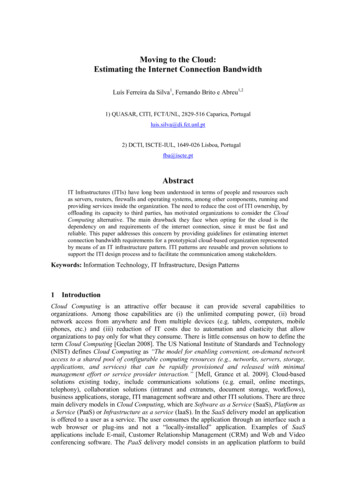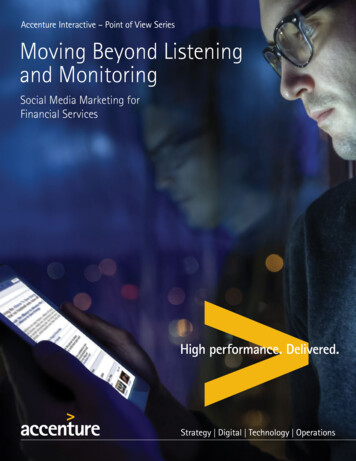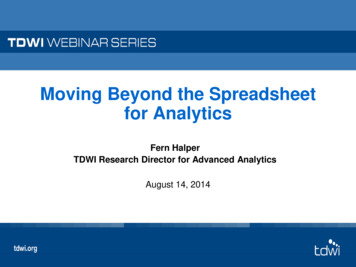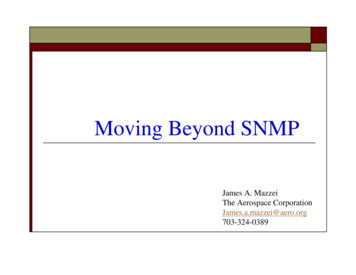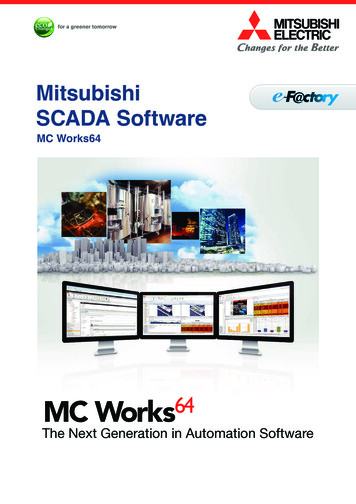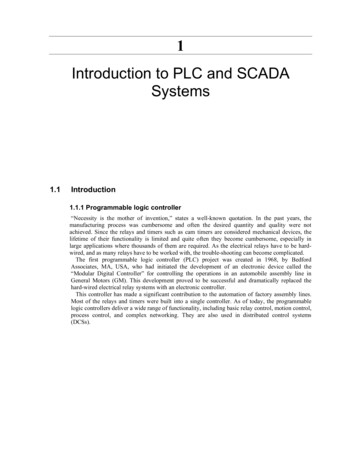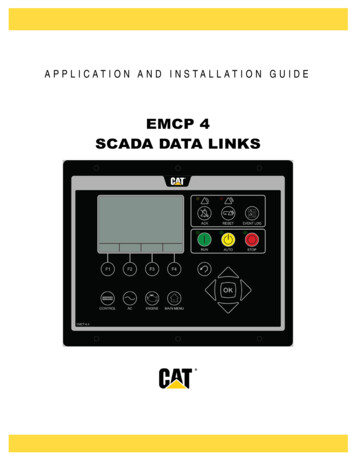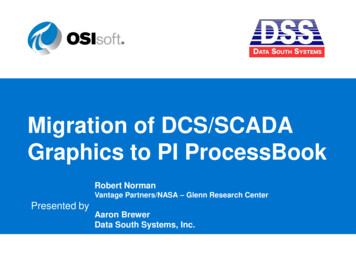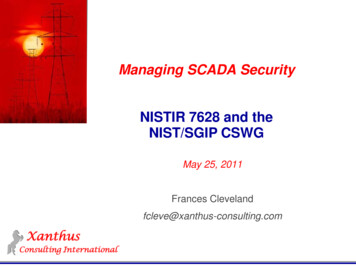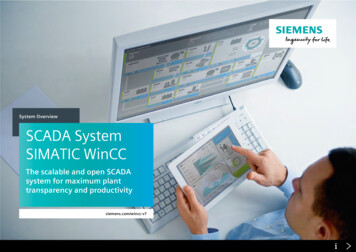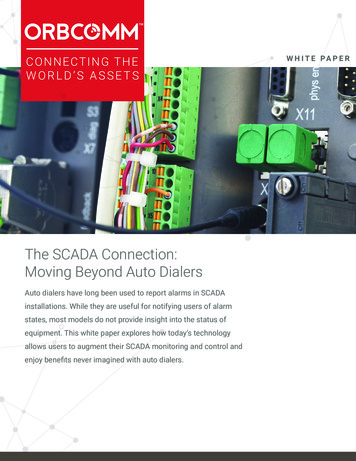
Transcription
C O N N E CT I N G T H EWORLD’S ASSETSThe SCADA Connection:Moving Beyond Auto DialersAuto dialers have long been used to report alarms in SCADAinstallations. While they are useful for notifying users of alarmstates, most models do not provide insight into the status ofequipment. This white paper explores how today’s technologyallows users to augment their SCADA monitoring and control andenjoy benefits never imagined with auto dialers.W H I T E PA P E R
OverviewAuto dialers have a long history of providing notifications inremote SCADA (Supervisory Control and Data Acquisition)installations. Most auto dialers detect possible alarmconditions by using discrete digital and analog portsconnected to sensors. Once a problem is detected, usersare notified when the device calls one or more pre-definedphone numbers to report the alarm conditions.While in some cases auto dialers are an effective way toremotely monitor pumps, valves, motors and switches,the evolution of SCADA installations has resulted in morecomplex equipment on site that needs to be monitoredand controlled.There is also a greater demand by SCADA users to optimizeoperations by automating functions that can be doneremotely in order to eliminate the costs and time requiredto send a technician to verify the existence of a problem,diagnose the root cause and plan for remediation.In this white paper we will explore how SCADA installationscan evolve from the use of auto dialers to a morecomprehensive way of managing remote sites thatincreases visibility while reducing costs.SCADA Applications – The BasicsSCADA technology is used in a number of industriesincluding the oil and gas, electricity, and water and wastewater industries. It is used to monitor and control equipmentof all sizes and complexities. SCADA systems gatherinformation such as pump on/off events, liquid flow, waterlevels, pressure values, and temperature readings and sendthem to a central management system.Traditionally, SCADA system operators were looking forconfirmation of basic functionality and notification whenabnormal events occurred. Examples of events include: Levels above/below predetermined thresholds Pump/generator on/off events or excessive startsHowever, as SCADA systems have evolved and operatorshave increased their demand for information, some datacannot be communicated easily using auto dialers overanalog phone landlines.Today’s SCADA – More Data, More OpportunitiesWireless communication has enhanced the possibilitiesin SCADA monitoring. Operations managers are no longerrestricted to relying on auto dialers connected to phonelines for communicating SCADA events. They now havemore physical reach by being able to monitor, controland automate equipment located at remote sites spreadover large geographical areas. It has also been part ofthe evolution that allowed customers to move away fromclosed, analog connections to digital and IP (InternetProtocol) based systems.As technology has evolved, SCADA remote monitoringand control equipment like PLCs (Programmable LogicControllers) and RTUs (Remote Terminal Units) have alsobecome more feature-rich (and complex). The increasein proliferation and functions of PLCs and RTUs meansthere is a greater depth of information available locally tooperations managers. However, the challenge is to exchangeinformation with the equipment in a timely manner andmake it available to the SCADA master station and users forviewing, interpretation and driving business keyperformance indicators.SCADA Sites – Designing And RetrofittingWhether you’re building a new SCADA site or retrofitting anexisting site, there are many points to consider so that youcan extract more comprehensive information. Building (orupgrading) a successful SCADA network depends not onlyon understanding today’s remote monitoring and controlrequirements but also on implementing a system that canscale up to tomorrow’s needs.Beyond the master station, the architecture of the SCADAnetwork comprises of three main components. These are: Intrusion detection Controllers or data terminal equipment (DTE) at theremote sites Power loss Data communication equipment (DCE) Temperature readings or pressure valuesabove/below thresholds Communication (telemetry) networkThese types of events are easily reported by simple autodialers using conventional phone lines when values havecrossed high or low set points.THE SCADA CONNECTION: MOVING BEYOND AUTO DIALERSControllers Or Data Terminal EquipmentToday’s controllers, whether they are PLCs, RTUs orintelligent communication terminals, come in varioussizes and capabilities to meet master station and remote2
station control needs. Here are 10 factors to consider whenselecting this type of equipment:1. Local intelligence and processing: is the unitprogrammable? What is the processing throughput?What is the data logging capacity of the unit?2. Input/output (I/O) ports: what is the number of I/Oports and what is their accuracy? Do they meet theneeds of the application?3. Communications: what telemetry communicationservices are supported? Are there provisions forredundant communications for critical applications?Can data be sent and received at the frequencyrequired by the application and the operationmanager?4. Protocols: does the unit support open standardindustry protocols like Modbus and DNP3 on serialand TCP/IP ports?5. Interfaces: what interfaces are required to connectto DCEs?6. Power: what are the power requirements of the unit?Can the unit be operated on battery alone? What arethe options for backup power?7. Enhanced security: does the equipment supportpassword-protected programming, authenticationand IP firewall capabilities?8. Durability and ruggedness: is the unit rated to handlethe temperature, humidity, vibration and electricalconditions found at the remote sites?9. Modularity: is the unit expandable as demand andneeds change?10. Space and installation: how much space is requiredby the controller and how will it be installed at theremote site?Data Equipment TerminalsIn some applications, ORBCOMM satellite devices are a verycost-effective way to add a controller with communicationcapability to a remote SCADA site.The IDP 600 series terminals feature four general input/output ports for connecting analog and digital sensors. Theterminals also have RS-232 and RS-485 ports for connectingdevices that communicate via serial protocols like Modbus.THE SCADA CONNECTION: MOVING BEYOND AUTO DIALERSThe onboard processor allows customers to program logicinto the device to react to events like “send a notificationwhen the water level is above the analog high threshold”or “close the valve when pressure reading is below lowthreshold”. This edge analytics capability reduces theamount of data that is sent wirelessly, thereby decreasingreaction time to events as well as monthly airtime costs.Data Communication EquipmentDCEs are responsible for the exchange of data betweencontrollers/DTEs and the master station. DCEs includeauto dialers as well as radio, cellular and satellite modemsand terminals. Here are 10 factors to keep in mind whenconsidering DCEs for SCADA sites:1. Availability: which communication networks areavailable at the remote sites? This will drive theselection of the DCE. Options include radio, privateleased lines, cellular and satellite.2. Redundancy: does the DCE have redundantcommunication options?3. Data requirements: does the unit support thetransmission of analog, digital and/or serial data?4. Data communication rate: how much data needsto be sent to and from the remote site? Will there bedemand to change the data as the site grows? Candata be sent and received as frequently as required?5. Transmission modes: does the site need half-duplexor full-duplex capability?6. Response time and latency: how much time does ittake to relay information between the controllers andthe master station? Does it meet the needs of theapplication?7. Interfaces: what interfaces are required to connect tothe controllers?8. Standards and certification: what communicationstandards need to be complied with in order tooperate in that region?9. Power: how much power is required to operate theDCE? Can the unit revert to backup power in theadvent of a failure on the main power line?10. Durability and ruggedness: is the unit rated to handlethe temperature, humidity, vibration and electricalconditions found at the remote sites?3
Building (or upgrading)a successful SCADAnetwork depends not onlyon understanding today’sremote monitoring andcontrol requirements butalso on implementing asystem that can scale upto tomorrow’s needs.
ORBCOMM Products as DCEsAn integral part of ORBCOMM’s IDP technology is theability to provide cost effective satellite communicationsfor remote sites requiring the ability to send notificationof events and alarms as well as regular telemetry data.Customers who opt for these solutions have the ability tosend and receive as much data as they want without beingconstrained to using time slots at specific times of day. Theyalso receive the information in seconds rather than minutesor hours.The IDP 600 series satellite-only devices are rugged andcompact. They are designed to be installed outside and arealso available with C1D2 (Class 1, Division 2) certification foruse in hazardous locations.The IDP 700 series satellite-cellular devices are equippedwith more than 17 I/O ports and can send information viasatellite, cellular or both, depending on need.Communication Telemetry NetworksThe communication network is the essential component forconnecting remote sites to master stations. When selectingthe primary and secondary communication systems,consider the following 10 factors:1. Coverage: is the network available at theremote sites?2. Uniformity: looking at the entire SCADA system, is itimportant to use the same communication networksacross all the sites? Choosing different networksdepending on local availability will increase thenumber of DCEs that need to be selected.3. Infrastructure: is there a need to installinfrastructure like towers and repeaters to supportthe communication network? What is the requiredinfrastructure investment? Can infrastructureinstallation and maintenance costs be outsourced toa cellular or satellite communication provider?4. Monthly costs: what are the recurring usage costs?5. Total cost of ownership: how do initial infrastructureand recurring monthly costs fit into the company’sfinancial policies?6. Reliability: what is the reliability of thecommunication network at each remote site?Does it meet the mandated or desired servicelevel agreement?THE SCADA CONNECTION: MOVING BEYOND AUTO DIALERS7. Data communication requirements: how much dataneeds to be sent to and from the remote site? Willthe data demand change as the site growsor evolves?8. Transmission modes: does the site need half-duplexor full-duplex capability?9. Responsiveness and latency: how much time does ittake to connect to the network and relay informationbetween the controllers and the master station?Does it meet the needs of the application? Howfrequently can data be polled from remote sites?10. Emergency management: does the communicationnetwork stand up to extreme weather like hurricanes,tornadoes and tsunamis?Benefits of increased visibility at remote sitesIncreased visibility of the status of equipment at remoteSCADA sites and the ability to collect more data than wasprovided solely by alarms (as offered by auto dialers) hastranslated into significant cost and operational savings formanagers. The benefits include: Reduced field visits, with lower labor and fuel costs. Ability to schedule maintenance on equipment basedon need rather than time passed. Decreased mean time to repair with real-time alertsof issues. Plus, being able to poll more data from thesites means being able to diagnose problems beforedispatching a technician. Minimized downtime by being alerted of degradation inperformance of equipmentTo achieve these results it is important to spend timeconsidering the architecture of your SCADA site includingthe DTE, DCE, communication telemetry network and howthe solution can meet today’s remote monitoring and controlrequirements but scale to tomorrow’s needs.Products and Communication NetworksThink satellite is expensive? Think again. ORBCOMMdevices are ideal for applications that require cost-effectiveconnectivity in remote areas where other communicationservices are unavailable or cost-prohibitive to implement.In some cases, customers who have chosen ORBCOMMsolutions pay less than they would for cellular solutions.5
The SCADA ConnectionFor more information about how ORBCOMM products can address your DTE, DCE andcommunication telemetry network needs, visit us at www.orbcomm.com.ORBCOMM Inc. (Nasdaq: ORBC) is a leading global provider of Machine-to-Machine (M2M) communication solutions and the only commercial satellitenetwork dedicated to M2M. ORBCOMM’s unique combination of global satellite, cellular and dual-mode network connectivity, hardware, web reportingapplications and software is the M2M industry’s most complete service offering. Our solutions are designed to remotely track, monitor, and control fixed andmobile assets in core vertical markets including transportation & distribution, heavy equipment, industrial fixed assets, oil & gas, maritime and government. R061516A
Auto dialers have a long history of providing notifications in remote SCADA (Supervisory Control and Data Acquisition) installations. Most auto dialers detect possible alarm conditions by using discrete digital and analog ports connected to sensors. Once a problem is detected, users a
